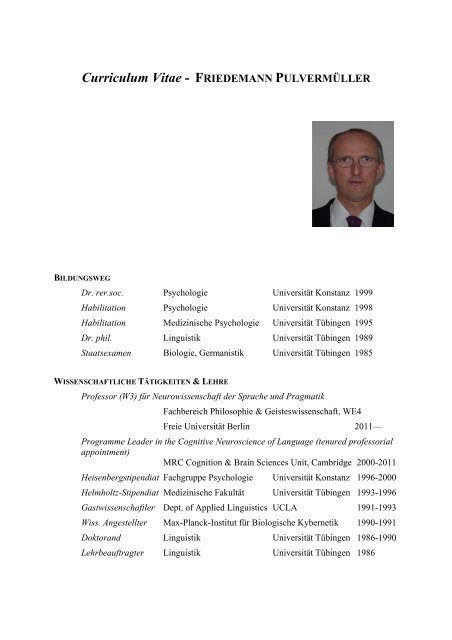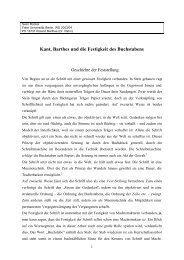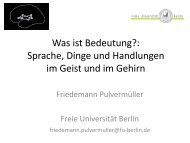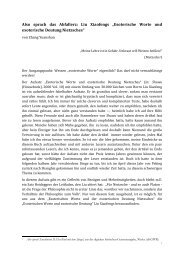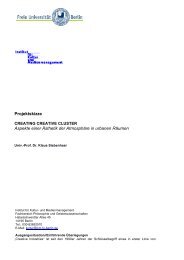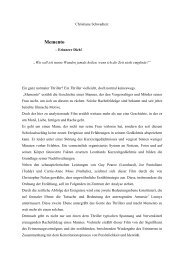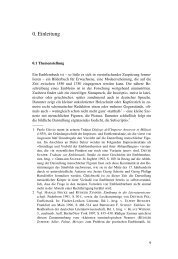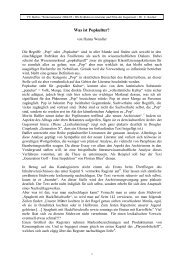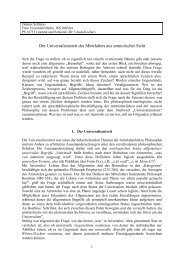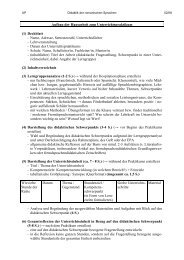CV von Friedemann Pulvermüller - Fachbereich Philosophie und ...
CV von Friedemann Pulvermüller - Fachbereich Philosophie und ...
CV von Friedemann Pulvermüller - Fachbereich Philosophie und ...
Create successful ePaper yourself
Turn your PDF publications into a flip-book with our unique Google optimized e-Paper software.
Curriculum Vitae - FRIEDEMANN PULVERMÜLLER<br />
BILDUNGSWEG<br />
Dr. rer.soc. Psychologie Universität Konstanz 1999<br />
Habilitation Psychologie Universität Konstanz 1998<br />
Habilitation Medizinische Psychologie Universität Tübingen 1995<br />
Dr. phil. Linguistik Universität Tübingen 1989<br />
Staatsexamen Biologie, Germanistik Universität Tübingen 1985<br />
WISSENSCHAFTLICHE TÄTIGKEITEN & LEHRE<br />
Professor (W3) für Neurowissenschaft der Sprache <strong>und</strong> Pragmatik<br />
<strong>Fachbereich</strong> <strong>Philosophie</strong> & Geisteswissenschaft, WE4<br />
Freie Universität Berlin 2011—<br />
Programme Leader in the Cognitive Neuroscience of Language (tenured professorial<br />
appointment)<br />
MRC Cognition & Brain Sciences Unit, Cambridge 2000-2011<br />
Heisenbergstipendiat Fachgruppe Psychologie Universität Konstanz 1996-2000<br />
Helmholtz-Stipendiat Medizinische Fakultät Universität Tübingen 1993-1996<br />
Gastwissenschaftler Dept. of Applied Linguistics UCLA 1991-1993<br />
Wiss. Angestellter Max-Planck-Institut für Biologische Kybernetik 1990-1991<br />
Doktorand Linguistik Universität Tübingen 1986-1990<br />
Lehrbeauftragter Linguistik Universität Tübingen 1986
Curriculum Vitae - F. PULVERMÜLLER<br />
WEITERE BERUFLICHE TÄTIGKEITEN<br />
Gastwissenschaftler MRC Cognition & Brain Sciences Unit, Cambridge 2011-2013<br />
Leiter, MEG & EEG MRC Cognition & Brain Sciences Unit, Cambridge 2007-2011<br />
Gastwissenschaftler Neurosci. Inst., University of California, Berkeley 2006<br />
Gastwissenschaftler Centre for Medicine and Health, Univ. of Malaga 2005—<br />
Gastwissenschaftler BioMag Lab, Helsinki University Central Hospital 1999-2005<br />
Gastwissenschaftler Cognitive Brain Res. Unit Universität Helsinki 1998—<br />
Gastwissenschaftler Cognitive Science Lab Universität Trient 1998-1999<br />
Gastwissenschaftler Dept. of Applied Linguistics UCLA 1995, 1998<br />
Gastwissenschaftler Forschergr. Biomagnetismus Universität Münster 1993<br />
Gastwissenschaftler Max Planck-Institut für Psycholinguistik 1993<br />
WISSENSCHAFTLICHE AUSZEICHNUNGEN, PREISE UND STIPENDIEN<br />
Fakultätsmitglied Graduate School of Mind and Brain, Berlin 2013—<br />
Honorarprofessor University of Plymouth 2012-2016<br />
Gastprofessor Universität Helsinki 2011<br />
Gastprofessor Anglia Ruskin University Cambridge 2007-2011<br />
Gastprofessor Fakultät f. Biol, Staatliche Universität St Petersburg 2007-2010<br />
Honorarprofessor School of Psychology, University of Wales, Bangor 2004—<br />
Fellow Wolfson College, Cambridge University 2003-2013<br />
Mitglied Rodin Remediation Academy, Stockholm 1999—<br />
Heisenberg-Stipendium Deutsche Forschungsgemeinschaft 1996<br />
Distinguished Scientific Award for Early Career Contributions to<br />
Psychophysiology, Society for Psychophysiological Research 1995<br />
Attempto-Preis<br />
für Hirnforschung Universität Tübingen 1994<br />
Helmholtz-Stipendium B<strong>und</strong>esministerium für Forschung 1993<br />
Gastprofessor Dept. of Applied Linguistics, UCLA 1992-1993<br />
Postdoktorandenstipendium Deutsche Forschungsgemeinschaft 1991<br />
Forschungsstipendium Stiftung zur Förderung der <strong>Philosophie</strong> 1988<br />
Doktorandenstipendium Land Baden-Württemberg 1986<br />
2
Curriculum Vitae - F. PULVERMÜLLER<br />
FORSCHUNGSPROJEKTE<br />
1. Projektleitung: F. <strong>Pulvermüller</strong><br />
Thema: Neurobiologie der Wortverarbeitung 1993-1995<br />
Förderung durch: Deutsche Forschungsgemeinschaft (AZ Pu 97/2-1)<br />
Förderungssumme: ca. 100.000 €<br />
2. Projektleitung: F. <strong>Pulvermüller</strong><br />
Thema: Lexikalische Defizite bei Hirnschädigung 1995-1998<br />
Förderung durch: Deutsche Forschungsgemeinschaft (AZ Pu 97/2-2)<br />
Förderungssumme: ca. 180.000 €<br />
3. Projektleitung: F. <strong>Pulvermüller</strong><br />
Thema: Neurobiologie der Wortverarbeitung 1996-1999<br />
Förderung durch: Deutsche Forschungsgemeinschaft (AZ Pu 97/2-3)<br />
Förderungssumme: ca. 100.000 €<br />
4. Projektleitung: F. <strong>Pulvermüller</strong><br />
Thema: Dynamik der Aktivierung kortikaler Netzwerke 1997-2001<br />
Förderung durch: Deutsche Forschungsgemeinschaft (AZ Pu 97/10-1)<br />
Förderungssumme: ca. 70.000 €<br />
5. Projektleitung: F. <strong>Pulvermüller</strong><br />
Thema: Physiologie der Assoziation <strong>von</strong> Wortbedeutungen 1998-2001<br />
Förderung durch: Deutsche Forschungsgemeinschaft (AZ Pu 97/11-1)<br />
Förderungssumme: ca. 70.000 €<br />
6. Projektleitung: F. <strong>Pulvermüller</strong><br />
Thema: The right hemisphere’s role in word processing 2000--2001<br />
Förderung durch: Universität Konstanz<br />
Förderungssumme: ca. 40.000 €<br />
7. Projektleitung: F. <strong>Pulvermüller</strong><br />
Thema: Neural basis of words, meaning and syntax 2000--2004<br />
Förderung durch: MRC (intramural project grant at CBU Cambridge)<br />
Förderungssumme: ca. € 1,2 Mio<br />
8. Projektleitung: B. Rockstroh & F. <strong>Pulvermüller</strong><br />
Thema: Constraint-Induced Aphasia Therapy 2001--2002<br />
Förderung durch: Stiftung ZNS (German CNS fo<strong>und</strong>ation)<br />
Förderungssumme: ca. 50.000 €<br />
9. Projektleitung: F. <strong>Pulvermüller</strong>, Gruppenkoordinierung: Stefan Wermter<br />
Thema:<br />
Mirrorbot: Language, action and perception in<br />
monkeys, humans and artifacts 2002--2005<br />
Förderung durch: European Union<br />
Förderungssumme: ca. € 1,7 Mio. insgesammt, € 435.000 für Cambridge-Anteil<br />
10. Projektleitung: F. <strong>Pulvermüller</strong><br />
Thema: Neural basis of words, meaning and syntax 2004--2009<br />
Förderung durch: MRC (interne Projektförduerung am CBU Cambridge)<br />
Förderungssumme: ca. € 1,5 Mio<br />
3
Curriculum Vitae - F. PULVERMÜLLER<br />
11. Antragsgruppe: W. Marslen-Wilson, F. <strong>Pulvermüller</strong>, R. Henson, Y. Shtyrov<br />
Ausstattung: MEG device Elekta-Neuromag Vectorview + MSR<br />
Förderung durch: Medical Research Council 2006<br />
Förderungssumme: ca. € 2,16 Mio<br />
12. Projektleitung: F. <strong>Pulvermüller</strong>, Gruppenkoordinierung: S. Wermter<br />
Thema:<br />
NESTcom: What it means to communicate<br />
Cambridge-Teil zur kognitiven Neurowissenschaft 2006--2008<br />
Förderung durch: EU, NEST Programm<br />
Förderungssumme: ca. € 249.000 insgesammt, € 82.000 für Cambridge-Anteil<br />
13. Projektleitung: W. Marslen-Wilson, F. <strong>Pulvermüller</strong>, R. Henson, Y. Shtyrov<br />
Thema:<br />
MRC-Elekta MEG Clinical Research Collaboration<br />
Förderung durch: Elekta-Neuromag, Stockholm/Helsinki 2007--2010<br />
Förderungssumme: ca. € 150.000<br />
14. Projektleitung: F. <strong>Pulvermüller</strong>, Y. Shtyrov (für MRC Cambridge)<br />
Thema:<br />
MEG Biomarkers of Schizophrenia<br />
Förderung durch: Glaxo-Smith-Kline 2008--2011<br />
Förderungssumme: ca. € 200.000<br />
15. Projektleitung: F. <strong>Pulvermüller</strong><br />
Thema:<br />
Brain dynamics of language in time and space<br />
Förderung durch: Medical Research Council (interne Förderung) 2009--2013<br />
Förderungssumme: ca. € 2,35 Mio.<br />
16. Projektleitung: F. <strong>Pulvermüller</strong><br />
Thema:<br />
Start up grant<br />
Förderung durch: Freie Universität Berlin 2011--2016<br />
Förderungssumme: ca. € 610.000<br />
17. Projektleitung: F. <strong>Pulvermüller</strong><br />
Thema:<br />
Bioinspired Architecture for Brain Embodied Language:BABEL<br />
Förderung durch: Engin. & Physical Sciences Research Council 2012--2016<br />
Förderungssumme: ca. € 550.000<br />
18. Projektleitung: H Kappelhoff et al., PI Gruppe; F <strong>Pulvermüller</strong>, Gruppenkoord.<br />
Thema:<br />
Interaction between motor, perceptual and linguistic systems<br />
Förderung durch: Deutsche Forschungsgemeinschaft 2012--2014<br />
Förderungssumme: ca. € 6.1 Mio overall, ca. € 305,000 for initiative<br />
19. Projektleitung: Marian Brady, Glasgow; Deutsche Koord.: F. <strong>Pulvermüller</strong><br />
Thema: COST Action Aphasia Trialists 2013--2016<br />
Förderung durch: EU<br />
Förderungssumme: ca. € 512.000<br />
20. Projektleitung: Sue Denham, Plymouth; FU Berlin-Partner: F. <strong>Pulvermüller</strong><br />
Thema: CogNovo Project, FP7-PEOPLE-2013-ITN 2013--2016<br />
Förderung durch: EU<br />
Förderungssumme: ca. € 4,07 Mio<br />
4
LEHRE FÜR BA- UND MA-STUDIERENDE IN DEN BEREICHEN<br />
Curriculum Vitae - F. PULVERMÜLLER<br />
Kognitive Neurowissenschaft, Psychophysiologie, Neuropsychologie,<br />
Psycholinguistik, Neurolinguistik, Neurowissenschaft der Sprache,<br />
Allgemeine Psychologie (Aufmerksamkeit, Emotion, Sprache, Gedächtnis,<br />
Wahrnehmung)<br />
Forschungsmethoden der Kognitionswissenschaft, Neuroimaging, v.a. MEG, EEG<br />
ADMINISTRATIVE TÄTIGKEITEN<br />
Mitglied bei administrativen Kommittees am MRC CBSU, einschließlich<br />
Unit Management Committee<br />
Imaging Management Committee<br />
Graduate Student Admission and Evaluation Committee<br />
MEG Management Committee (Chair)<br />
An der Freien Universität Berlin:<br />
Leitung, Brain Language Laboratory, FU Berlin<br />
Stellvertretendes Mitglied, Institutsrat, WE4 des FB <strong>Philosophie</strong><br />
Mitglied, Komitee für Karriereförderung <strong>von</strong> Nachwichswissenschaftlern der<br />
Graduate School of Mind and Brain<br />
MITGLIEDSCHAFTEN IN WISSENSCHAFTLICHEN GESELLSCHAFTEN UND VEREINIGUNGEN<br />
Cognitive Neuroscience Society (CNS), USA<br />
Experimental Psychology Society (EPS), UK<br />
Organization for Human Brain Mapping (OHBM), USA<br />
Society for Psychophysiological Research (SPR), USA<br />
Society for Neuroscience (SfN), USA<br />
World Federation of Neurology (WFN) – Research Group on Aphasia and Cognitive<br />
Disorders (RGACD)<br />
Society for the Neurobiology of Language (NBL), USA<br />
HERAUSGEBER FÜR FACHZEITSCHRIFTEN<br />
Gastherausgeber, Cortex 2009-2012<br />
Gastherausgeber, Brain and Language 2008-2011<br />
Gastherausgeber, Neural Networks 2007-2009<br />
Herausgebergremium, Biolinguistics 2010—<br />
Review Editor, Frontiers in Human Neuroscience 2007—<br />
Herausgebergremium, Brain and Language 2007—<br />
Herausgebergremium, Brain Topography 2007—<br />
Herausgebergremium, Aphasiology 1999—<br />
GUTACHTERTÄTIGKEITEN FÜR INSTITUTIONEN DER FORSCHUNGSFÖRDERUNG<br />
Biotechnology and Biological Sciences Research Council (BBSRC), UK<br />
Deutsche Forschungsgemeinschaft (DFG)<br />
Dutch Science Fo<strong>und</strong>ation, die Niederlande<br />
Engineering and Physical Sciences Research Council (EPSRC), UK<br />
Finnish Academy of Science, Finland<br />
Medical Research Council (MRC), UK<br />
5
Curriculum Vitae - F. PULVERMÜLLER<br />
National Science Fo<strong>und</strong>ation (NSF), USA<br />
Stiftung ZNS<br />
Stroke Association, UK<br />
Wellcome Trust, UK<br />
<strong>und</strong> viele weitere<br />
GUTACHTER FÜR FACHZEITSCHRIFTEN (EXEMPLARISCH)<br />
Aphasiology<br />
Behavioral and Brain Sciences<br />
Biological Psychology<br />
Brain and Language<br />
Clinical Neurophysiology/Electroencephalography and Clinical Neurophysiology<br />
Brain Research, Cognitive Brain Research<br />
Cognitive Neuropsychology<br />
Cognitive Psychology<br />
Cognitive Science<br />
Connection Science<br />
Current Biology<br />
European Journal of Neuroscience<br />
Experimental Brain Research<br />
International Journal of Psychophysiology<br />
Issues in Applied Linguistics<br />
Journal of Cognitive Neuroscience<br />
Journal of Neuroscience<br />
Journal of Psychophysiology<br />
Language and Cognitive Processes<br />
Nature, Nature Neuroscience, Nature Reviews Neuroscience<br />
Neural Networks<br />
Neurocase<br />
Neuroimage<br />
Neuron<br />
Neuropsychologia<br />
Proceedings of the National Academy of Sciences, USA<br />
Psychophysiology<br />
Trends in Cognitive Sciences<br />
Science<br />
<strong>und</strong> viele weitere<br />
BIBLIOGRAPHISCHE INFORMATION<br />
Number of publications: >240, incl. >190 peer reviewed, ~45 other articles, 4 books<br />
Hirsch (h) index: 60; Number of citations: overall >12,800 (google scholar)<br />
6
Curriculum Vitae - F. PULVERMÜLLER<br />
Publikationen<br />
[A]<br />
MONOGRAPHIEN, DISSERTATIONEN, HERAUSGEGEBENE SAMMELBÄNDE<br />
1. <strong>Pulvermüller</strong>, F. 1990. Aphasische Kommunikation. Gr<strong>und</strong>fragen ihrer<br />
Analyse <strong>und</strong> Therapie. Sprachtherapie 2. [Aphasic Communication. Key<br />
questions of its analysis and therapy]. Gunter Narr Verlag: Tübingen.<br />
2. <strong>Pulvermüller</strong>, F. 1996. Neurobiologie der Sprache [Neurobiology Of<br />
Language]. Gehirntheoretische Überlegungen <strong>und</strong> empirische Bef<strong>und</strong>e zur<br />
Sprachverarbeitung. Psychologia Universalis 1. Pabst Science Publishers:<br />
Lengerich, Berlin.<br />
3. <strong>Pulvermüller</strong>, F. 2001. Neuronal grammar. An essay on brain mechanisms<br />
of serial order. Doctoral dissertation, University of Konstanz.<br />
4. <strong>Pulvermüller</strong>, F. 2003. The Neuroscience Of Language: On Brain Circuits<br />
Of Words and Serial Order. Cambridge University Press, Cambridge, UK.<br />
5. Shtyrov, Y. & <strong>Pulvermüller</strong>, F. (eds.) 2006. Fourth Conference On Mismatch<br />
Negativity (MMN) And Its Clinical And Scientific Applications, April 22-26,<br />
2006. MRC Cognition and Brain Sciences Unit, Cambridge, UK.<br />
6. Wermter, S., Page, M., Knowles, M., Gallese, V., <strong>Pulvermüller</strong>, F., & Taylor,<br />
J. (eds.) 2009. Multimodal communication in animals, humans and robots.<br />
Special issue of the journal Neural Networks, 22 (2).<br />
7. Knoeferle, P., Crocker, M. W., & <strong>Pulvermüller</strong>, F. (eds.) 2010. Embodied<br />
sentence processing. Special issue of the journal Brain and Language, 112 (3).<br />
8. Cappa, S., & <strong>Pulvermüller</strong>, F. (eds.) 2012. Language and the Motor System.<br />
Special Issue of the Journal Cortex, 48 (7).<br />
9. Berthier, M. L., Green, C., Juárez, R., Lara, J. P., & <strong>Pulvermüller</strong>, F. 2013.<br />
REGIA: Rehabilitación grupal intensiva de la afasia. Madrid: TEA<br />
Ediciones, S.A.<br />
[B]<br />
ARTIKEL IN INTERNATIONALEN REFERIERTEN FACHZEITSCHRIFTEN<br />
1991<br />
10. <strong>Pulvermüller</strong>, F. & Preißl, H. 1991: A cell assembly model of language.<br />
Network: Computation in Neural Systems 2, 455-468.<br />
11. <strong>Pulvermüller</strong>, F. & Roth, V.M. 1991: Communicative aphasia treatment as a<br />
further development of PACE-therapy. Aphasiology 5, 39-50.<br />
7
Curriculum Vitae - F. PULVERMÜLLER<br />
1992<br />
12. <strong>Pulvermüller</strong>, F. 1992: Constituents of a neurological theory of language.<br />
Concepts in Neuroscience 3, 157-200.<br />
13. Braitenberg, V. & <strong>Pulvermüller</strong>, F. 1992: Entwurf einer neurologischen<br />
Theorie der Sprache. Naturwissenschaften 79, 103-117.<br />
1993<br />
14. <strong>Pulvermüller</strong>, F. & Schönle, P.-W. 1993: Behavioral and neuronal changes<br />
during treatment of mixed transcortical aphasia. Cognition 48, 139-161.<br />
1994<br />
15. <strong>Pulvermüller</strong>, F. 1994: Why cell assembly ignition should lead to gamma band<br />
responses. Psycoloquy 5 (65), 1-6.<br />
16. <strong>Pulvermüller</strong>, F. & Lutzenberger, W. 1994: Specific gamma-band depression<br />
and linguistic units. Psycoloquy 5 (68), 1-8.<br />
17. <strong>Pulvermüller</strong>, F. & Preißl, H. 1994: Explaining aphasias in neuronal terms.<br />
Journal of Neurolinguistics 8, 75-81<br />
18. <strong>Pulvermüller</strong>, F. Preißl, H., Eulitz, C., Pantev, C., Lutzenberger, W., Elbert, T.<br />
& Birbaumer, N. 1994: Brain rhythms, cell assemblies and cognition:<br />
evidence from the processing of words and pseudowords. Psycoloquy 5 (48),<br />
1-30.<br />
19. <strong>Pulvermüller</strong>, F., Preißl, H., Lutzenberger, W. & Birbaumer, N. 1994: Simple<br />
models first. Psycoloquy 5 (66), 1-4.<br />
20. <strong>Pulvermüller</strong>, F. & Schumann, J.H. 1994: Neurobiological mechanisms of<br />
language acquisition. Language Learning 44, 681-734.<br />
21. Lutzenberger, W., <strong>Pulvermüller</strong>, F. & Birbaumer, N. 1994: Words and<br />
pseudowords elicit distinct patterns of 30-Hz EEG responses in humans.<br />
Neuroscience Letters 176, 115-118.<br />
22. Lutzenberger, W., <strong>Pulvermüller</strong>, F., Elbert, T. & Birbaumer, N. 1994:<br />
Increased gamma-band power: new data against old prejudices. Psycoloquy 5<br />
(67), 1-9.<br />
23. Mohr, B., <strong>Pulvermüller</strong>, F., Rayman, J. & Zaidel, E. 1994: Interhemispheric<br />
cooperation during lexical processing is mediated by the corpus callosum:<br />
evidence from the split-brain. Neuroscience Letters 181, 17-21.<br />
24. Mohr, B., <strong>Pulvermüller</strong>, F. & Zaidel, E. 1994: Lexical decision after left, right,<br />
and bilateral presentation of content words, function words, and non-words:<br />
evidence for interhemispheric interaction. Neuropsychologia 32, 105-124.<br />
8
Curriculum Vitae - F. PULVERMÜLLER<br />
1995<br />
25. <strong>Pulvermüller</strong>, F. 1995: Agrammatism: behavioral description and<br />
neurobiological explanation. Journal of Cognitive Neuroscience 7, 165-181.<br />
26. <strong>Pulvermüller</strong>, F. 1995: What neurobiology can buy language theory. Studies<br />
in Second Language Acquisition 17, 73-77.<br />
27. <strong>Pulvermüller</strong>, F. 1995: Neurobiologie der Wortverarbeitung.<br />
Naturwissenschaften 82, 279-287.<br />
28. <strong>Pulvermüller</strong>, F., Lutzenberger, W. & Birbaumer, N. 1995: Electrocortical<br />
distinction of vocabulary types. Electroencephalography and Clinical<br />
Neurophysiology 94, 357-370.<br />
29. <strong>Pulvermüller</strong>, F., Lutzenberger, W. Preißl, H. & Birbaumer, N. 1995: Motor<br />
programming in both hemispheres: an EEG study of the human brain.<br />
Neuroscience Letters 189, 5-8.<br />
30. <strong>Pulvermüller</strong>, F., Lutzenberger, W. Preißl, H. & Birbaumer, N. 1995: Spectral<br />
responses in the gamma-band: physiological signs of higher cognitive<br />
processes? NeuroReport 6, 2059-2064.<br />
31. <strong>Pulvermüller</strong>, F. & Preißl, H. 1995: Local or transcortical assemblies?<br />
Evidence from cognitive neuroscience (Response to D. Amit). Behavioral and<br />
Brain Sciences 18, 640-641.<br />
32. <strong>Pulvermüller</strong>, F. & Schumann, J.H. 1995: On the interpretation of earlier<br />
recovery of the second language after injection of sodium Amytal in the left<br />
middle cerebral artery. Language Learning 45, 729-73<br />
33. Lutzenberger, W., Preißl, H. & <strong>Pulvermüller</strong>, F. 1995: Fractal dimension of<br />
EEG time series and <strong>und</strong>erlying brain processes. Biological Cybernetics 73,<br />
477-482.<br />
34. Lutzenberger, W., <strong>Pulvermüller</strong>, F., Elbert, T. & Birbaumer, N. 1995: Visual<br />
stimulation alters local 40-Hz responses in humans: an EEG study.<br />
Neuroscience Letters 183, 39-42.<br />
35. Preißl, H., <strong>Pulvermüller</strong>, F., Lutzenberger, W. & Birbaumer, N. 1995: Evoked<br />
potentials distinguish between nouns and verbs. Neuroscience Letters 197, 81-<br />
83.<br />
1996<br />
36. <strong>Pulvermüller</strong>, F. 1996: Hebb's concept of cell assemblies and the<br />
psychophysiology of word processing. Psychophysiology 33, 317-333.<br />
37. <strong>Pulvermüller</strong>, F., Eulitz, C., Pantev, C., Mohr, B., Feige, B., Lutzenberger, W.,<br />
Elbert, T. & Birbaumer, N. 1996: High-frequency cortical responses reflect<br />
9
Curriculum Vitae - F. PULVERMÜLLER<br />
lexical processing: an MEG study. Electroencephalography and Clinical<br />
Neurophysiology 98, 76-85.<br />
38. <strong>Pulvermüller</strong>, F., Lutzenberger, W., Müller, V., Mohr, B., Dichgans, J. &<br />
Birbaumer, N. 1996: P3 and contigent negative variation in Parkinson's<br />
disease. Electroencephalography and Clinical Neurophysiology 98, 456-467.<br />
39. <strong>Pulvermüller</strong>, F. & Mohr, B. 1996: Transcortical cell assemblies: A key to the<br />
<strong>und</strong>erstanding of cortical lateralization and interhemispheric interaction.<br />
Neuroscience and Biobehavioral Reviews 30, 557-566.<br />
40. <strong>Pulvermüller</strong>, F., Mohr, B. & Preißl, H. 1996: Biology of language: principles,<br />
predictions, and evidence. Behavioral and Brain Sciences 19, 643-644.<br />
41. <strong>Pulvermüller</strong>, F., Mohr, B., Sedat, N., Hadler, B. & Rayman, J. 1996: Word<br />
class specific deficits in Wernicke's aphasia. Neurocase 2, 203-212.<br />
42. <strong>Pulvermüller</strong>, F., Preißl, H., Lutzenberger, W. & Birbaumer, N. 1996: Brain<br />
rhythms of language: nouns versus verbs. European Journal of Neuroscience<br />
8, 937-941.<br />
43. Mohr, B., <strong>Pulvermüller</strong>, F., Mittelstädt, K. & Rayman, J. 1996: Multiple<br />
simultaneous stimulus presentation facilitates lexical processing.<br />
Neuropsychologia 34, 1003-1013.<br />
44. Mohr, B., Müller, V., Mattes, R., Rosin, R., Federmann, B., Strehl, U.,<br />
<strong>Pulvermüller</strong>, F., Müller, F. & Birbaumer, N. 1996: Behavioral treatment of<br />
Parkinson's disease leads to improvement of motor skills and to tremor<br />
reduction. Behavior Therapy 27, 235-255.<br />
45. Montoya, P., Larbig, W., <strong>Pulvermüller</strong>, F., Flor, H. & Birbaumer, N. 1996:<br />
Cortical correlates of semantic classical conditioning. Psychophysiology 33,<br />
644-649.<br />
46. Preißl, H., Lutzenberger, W. & <strong>Pulvermüller</strong>, F. 1996: Is there chaos in the<br />
brain? Behavioral and Brain Sciences 19, 307-308.<br />
1997<br />
47. <strong>Pulvermüller</strong>, F. 1997: Aspects of language mechanisms: a Hebbian<br />
perspective. European Review 5, 23-37.<br />
48. <strong>Pulvermüller</strong>, F. 1997: Brain-theoretical perspectives on language.<br />
Theoretical Linguistics 23, 281-302.<br />
49. <strong>Pulvermüller</strong>, F., Birbaumer, N., Lutzenberger, W. & Mohr, B. 1997: Highfrequency<br />
cortical activity: its possible role in attention, gestalt processing and<br />
language. Progress in Neurobiology 52, 427-445.<br />
10
Curriculum Vitae - F. PULVERMÜLLER<br />
50. Lutzenberger, W., Preißl, H., Birbaumer, N. & <strong>Pulvermüller</strong>, F. 1997: Highfrequency<br />
cortical responses: do they not exist if they are small?<br />
Electroencephalography and Clinical Neurophysiology 102, 64-66.<br />
51. Müller, V., Mohr, B., Rosin, R., <strong>Pulvermüller</strong>, F., Müller, F. & Birbaumer, N.<br />
1997: Short-term effects of behavioural treatment on movement initiation and<br />
postural control in Parkinson's disease: a controlled clinical study. Movement<br />
Disorders 12, 306-314.<br />
52. Preißl, H., Lutzenberger, W., <strong>Pulvermüller</strong>, F. & Birbaumer, N. 1997: Fractal<br />
dimensions of short EEG time series in humans. Neuroscience Letters 225,<br />
77-80.<br />
1998<br />
53. <strong>Pulvermüller</strong>, F. 1998: On the matter of rules. Past tense-formation and its<br />
relevance for cognitive neuroscience. Network: Computation in Neural<br />
Systems 9 R, 1-52.<br />
54. Mohr, B., <strong>Pulvermüller</strong>, F. & Schleichert, H. 1998: Learned changes of brain<br />
states alter cognitive processing in humans. Neuroscience Letters 253, 159-<br />
162.<br />
55. Dobel, C., Hauk, O., Zobel, E., Eulitz, C., <strong>Pulvermüller</strong>, F., Cohen, R.,<br />
Schönle, P.W., Elbert, T. & Rockstroh, B. 1998: Monitoring brain activity of<br />
human subjects during delayed matching to sample tasks comparing verbal and<br />
pictorial stimuli with modal and cross-modal presentation: an event related<br />
potential study employing a source reconstruction method. Neuroscience<br />
Letters 253, 179-182.<br />
1999<br />
56. <strong>Pulvermüller</strong>, F. 1999: Words in the brain's language (Target Article).<br />
Behavioral and Brain Sciences 22, 253-279.<br />
57. <strong>Pulvermüller</strong>, F. 1999: Toward a Cognitive Neuroscience of Language<br />
(Response to Commentaries). Behavioral and Brain Sciences 22, 301-336.<br />
58. <strong>Pulvermüller</strong>, F. 1999: Lexical access as a brain mechanism (Commentary on<br />
Levelt). Behavioral and Brain Sciences 22, 50-52.<br />
59. <strong>Pulvermüller</strong>, F. 1999: Mind the brain, and brain the mind! (Commentary on<br />
Clahsen). Behavioral and Brain Sciences 22, 1035-1036.<br />
60. <strong>Pulvermüller</strong>, F., Keil, A. & Elbert, T. 1999: High-frequency brain activity:<br />
perception or active memory? Trends in Cognitive Sciences, 3, 250-252.<br />
61. <strong>Pulvermüller</strong>, F., Preißl, H. & Lutzenberger, W. 1999: Nouns and verbs in the<br />
intact brain: evidence from event-related potentials and high-frequency cortical<br />
responses. Cerebral Cortex, 9, 497-506.<br />
11
Curriculum Vitae - F. PULVERMÜLLER<br />
62. <strong>Pulvermüller</strong>, F., Mohr, B. & Schleichert, H. 1999: Semantic or lexicosyntactic<br />
factors: What determines word-class-specific activity in the human<br />
brain? Neuroscience Letters, 275, 81-84.<br />
2000<br />
63. <strong>Pulvermüller</strong>, F. 2000: Syntactic circuits: How does the brain create serial<br />
order in sentences? Brain and Language, 71, 194-199.<br />
64. <strong>Pulvermüller</strong>, F., Härle & Hummel, F. 2000: Neurophysiological distinction of<br />
semantic verb categories. NeuroReport, 11, 2789-2793.<br />
65. <strong>Pulvermüller</strong>, F., Mohr, B., Schleichert, H. & Veit, R. 2000: Operant<br />
conditioning of left-hemispheric slow cortical potentials and its effect on word<br />
processing. Biological Psychology, 53, 177-215.<br />
66. Mohr, B., <strong>Pulvermüller</strong>, F., Cohen, R. & Rockstroh, B. 2000:<br />
Interhemispheric cooperation during word processing: evidence for callosal<br />
dysfunction in schizophrenic patients. Schizophrenia Research, 46, 231-239.<br />
2001<br />
67. <strong>Pulvermüller</strong>, F. 2001: Brain reflections of words and their meaning. Trends in<br />
Cognitive Sciences, 5, 517-524.<br />
68. <strong>Pulvermüller</strong>, F. 2001: Mutual access and mutual dependence of conceptual<br />
components. (Commentary on Humphreys and Forde.) Behavioral and Brain<br />
Sciences, 24, 490-492.<br />
69. <strong>Pulvermüller</strong>, F., Assadollahi, R. & Elbert, T. 2001: Neuromagnetic evidence<br />
for early semantic access in word recognition. European Journal of<br />
Neuroscience, 13, 201-205.<br />
70. <strong>Pulvermüller</strong>, F., Neininger, B., Elbert, T., Mohr, B., Rockstroh, B., Koebbel,<br />
P. & Taub, E. 2001: Constraint-induced therapy of chronic aphasia following<br />
stroke. Stroke, 32, 1621-1626.<br />
71. <strong>Pulvermüller</strong>, F., Härle, M. & Hummel, F. 2001: Walking or talking?:<br />
Behavioral and electrophysiological correlates of action verb processing.<br />
Brain and Language, 78, 143-168.<br />
72. <strong>Pulvermüller</strong>, F., Kujala, T., Shtyrov, Y., Simola., J., Tiitinen, H., Alku, P.,<br />
Alho, K., Martinkauppi, S., Ilmoniemi, R. J. & Näätänen, R. 2001: Memory<br />
traces for words as revealed by the Mismatch Negativity (MMN). NeuroImage,<br />
14, 107-616.<br />
73. Assadollahi, R. & <strong>Pulvermüller</strong>, F. 2001: Neuromagnetic evidence for early<br />
access to cognitive representations. Neuroreport, 12, 207-213.<br />
12
Curriculum Vitae - F. PULVERMÜLLER<br />
74. Dobel, C., <strong>Pulvermüller</strong>, F., Härle, M., Cohen, R., Koebbel, P., Schonle, P.W.<br />
& Rockstroh, B. 2001: Syntactic and semantic processing in the healthy and<br />
aphasic human brain. Experimental Brain Research, 140, 77-85.<br />
75. Mohr, B., Heim, S., <strong>Pulvermüller</strong>, F. & Rockstroh, B. 2001: Functional<br />
asymmetry in schizophrenic patients during auditory speech processing.<br />
Schizophrenia Research, 52, 69-78.<br />
76. Müller, V., Lutzenberger, W., <strong>Pulvermüller</strong>, F. & Mohr, B. 2001: Investigation<br />
of brain dynamics in Parkinson's disease by methods derived from nonlinear<br />
dynamics. Experimental Brain Research, 137, 103-110.<br />
77. Neininger, B. & <strong>Pulvermüller</strong>, F. 2001: The right hemisphere’s role in action<br />
verb processing: A double case study. Neurocase, 7, 103-317.<br />
2002<br />
78. <strong>Pulvermüller</strong>, F. 2002: A brain perspective on language mechanisms: from<br />
discrete neuronal ensembles to serial order. Progress in Neurobiology, 67, 85-<br />
111.<br />
79. Mohr, B. & <strong>Pulvermüller</strong>, F. 2002: Red<strong>und</strong>ancy gains and costs in cognitive<br />
processing: the effect of short SOAs. Journal of Experimental Psychology:<br />
Learning, Memory, and Cognition, 28(6), 1200-1223.<br />
80. Shtyrov, Y. & <strong>Pulvermüller</strong>, F. 2002: Processing of an inflectional affix by the<br />
human brain as revealed by the Mismatch Negativity (MMN). European<br />
Journal of Neuroscience, 15, 1085-1091.<br />
81. Shtyrov, Y. & <strong>Pulvermüller</strong>, F. 2002: Neurophysiological evidence for<br />
memory traces for words in the human brain. Neuroreport, 13, 521-525.<br />
2003<br />
82. <strong>Pulvermüller</strong>, F. 2003: Sequence detectors as a basis of grammar in the brain.<br />
Theory in Biosciences, 122, 87-103.<br />
83. <strong>Pulvermüller</strong>, F. & Shtyrov, Y. 2003: Automatic processing of grammar in the<br />
human brain as revealed by the Mismatch Negativity. Neuroimage, 20, 1020-<br />
1025.<br />
84. <strong>Pulvermüller</strong>, F., Shtyrov, Y. & Ilmoniemi, R. 2003: Spatio-temporal patterns<br />
of neural language processing: an MEG study using Minimum-Norm Current<br />
Estimates. Neuroimage, 20, 159-172.<br />
85. Assadollahi, R. & <strong>Pulvermüller</strong>, F. 2003: Early influences of word length and<br />
frequency: a group study in the MEG. Neuroreport, 14, 1183-1187.<br />
13
Curriculum Vitae - F. PULVERMÜLLER<br />
86. Micheyl, C., Carlyon, R.P., Shtyrov, Y., Hauk, O., Dodson, T. & <strong>Pulvermüller</strong>,<br />
F. 2003: Neurophysiological correlates of a perceptual illusion: A Mismatch<br />
Negativity study. Journal of Cognitive Neuroscience, 15, 747-758.<br />
87. Müller, V., Lutzenberger, W., Preißl, H., <strong>Pulvermüller</strong>, F. & Birbaumer, N.<br />
2003: Complexity of visual stimuli and non-linear EEG dynamics in humans.<br />
Cognitive Brain Research, 16, 104-110.<br />
88. Neininger, B. & <strong>Pulvermüller</strong>, F. 2003: Word category specific deficits after<br />
right-hemispheric lesions. Neuropsychologia, 41, 53-70.<br />
89. Shtyrov, Y., <strong>Pulvermüller</strong>, F., Näätänen, R. & Ilmoniemi, R. 2003: Grammar<br />
processing outside the focus of attention: an MEG study. Journal of Cognitive<br />
Neuroscience, 15, 1195-1206.<br />
2004<br />
90. <strong>Pulvermüller</strong>, F. 2004: Lexical access as a brain mechanism. Behavioral and<br />
Brain Sciences, 27, 297-298.<br />
91. <strong>Pulvermüller</strong>, F. & Mohr, B. 2004: Determinants of ignition times:<br />
Topographies of cell assemblies and activation delays they imply. Behavioral<br />
and Brain Sciences, 27, 308-311.<br />
92. <strong>Pulvermüller</strong>, F., Mohr, B. & Lutzenberger, W. 2004: Neurophysiological<br />
signs of word and pseudoword processing in well-recovered aphasics and<br />
patients with right hemispheric stroke. Psychophysiology, 41, 584-591..<br />
93. <strong>Pulvermüller</strong>, F., Shtyrov, Y., Kujala, T. & Näätänen, R. 2004: Word-specific<br />
cortical activity as revealed by the mismatch negativity. Psychophysiology, 41,<br />
106-112.<br />
94. Endrass, T., Mohr, B. & <strong>Pulvermüller</strong>, F. 2004: Enhanced mismatch negativity<br />
brain response after binaural word presentation. European Journal of<br />
Neuroscience, 19, 1653-1660.<br />
95. Hauk, O., Johnsrude, I. & <strong>Pulvermüller</strong>, F. 2004: Somatotopic representation<br />
of action words in human motor and premotor cortex. Neuron, 41, 301-307.<br />
96. Hauk, O. & <strong>Pulvermüller</strong>, F. 2004: Neurophysiological distinction of action<br />
words in the fronto-central cortex. Human Brain Mapping, 21, 191-201.<br />
97. Hauk, O. & <strong>Pulvermüller</strong>, F. 2004: Effects of word length and frequency on<br />
the human event-related potential. Clinical Neurophysiology, 115, 1090-1103.<br />
98. Shtyrov, Y., Hauk, O. & <strong>Pulvermüller</strong>, F. 2004: Distributed neuronal networks<br />
for encoding category-specific semantic information: the mismatch negativity<br />
to action words. European Journal of Neuroscience, 19, 1083-1092.<br />
14
Curriculum Vitae - F. PULVERMÜLLER<br />
99. Wermter, S., Weber, C., Elshaw, M., Panchev, C., Erwin, H. & <strong>Pulvermüller</strong>,<br />
F. 2004: Towards multimodal neural robot learning. Robotics and Autonomous<br />
Systems, 47, 171-175.<br />
2005<br />
100. <strong>Pulvermüller</strong>, F. 2005: Brain mechanisms linking language and action. Nature<br />
Reviews Neuroscience, 6 (7), 576-582.<br />
101. <strong>Pulvermüller</strong>, F. 2005: From babbling to articulatory echo neurons and<br />
unsolved questions of syntax. Behavioral and Brain Sciences,<br />
http://www.bbsonline.org/Preprints/Arbib-05012002/Supplemental/Pulvermuller.pdf<br />
102. <strong>Pulvermüller</strong>, F., Shtyrov, Y. & Ilmoniemi, R. 2005: Brain signatures of<br />
meaning access in action word recognition. Journal of Cognitive<br />
Neuroscience, 17 (6), 884-892.<br />
103. <strong>Pulvermüller</strong>, F., Hauk, O., Nikulin, V. & Ilmoniemi, R.J. 2005: Functional<br />
interaction of language and action: a TMS study. European Journal of<br />
Neuroscience, 21 (3), 793-797.<br />
104. <strong>Pulvermüller</strong>, F., Hauk, O., Zohsel, K., Neininger, B. & Mohr, B. 2005:<br />
Therapy-related reorganization of language in both hemispheres of patients<br />
with chronic aphasia. Neuroimage, 28 (2), 481-489.<br />
105. Shtyrov, Y., Pihko, E. & <strong>Pulvermüller</strong>, F. 2005: Determinants of dominance: Is<br />
language laterality explained by physical or linguistic features of speech?<br />
Neuroimage, 27 (1), 37-47.<br />
2006<br />
106. <strong>Pulvermüller</strong>, F., & Hauk, O. 2006. Category-specific processing of color and<br />
form words in left fronto-temporal cortex. Cerebral Cortex, 16 (8), 1193-1201.<br />
107. <strong>Pulvermüller</strong>, F., Huss, M., Kherif, F., Moscoso del Prado Martin, F., Hauk,<br />
O., & Shtyrov, Y. 2006. Motor cortex maps articulatory features of speech<br />
so<strong>und</strong>s. Proceedings of the National Academy of Sciences, U.S.A., 103 (20),<br />
7865-7870.<br />
108. <strong>Pulvermüller</strong>, F., & Shtyrov, Y. 2006. Language outside the focus of attention:<br />
the mismatch negativity as a tool for studying higher cognitive processes.<br />
Progress in Neurobiology, 79 (1), 49-71.<br />
109. <strong>Pulvermüller</strong>, F., Shtyrov, Y., Ilmoniemi, R. J. & Marslen-Wilson, W. 2006:<br />
Mapping speech comprehension in space and time. Neuroimage, 31 (3), 1297-<br />
1303.<br />
110. Bak, T. H., Yancopoulu, D., Nestor, P., Xuereb, J., Spillantini, M. G.,<br />
<strong>Pulvermüller</strong>, F., & Hodges, J. R. 2006: Clinical, imaging and pathological<br />
15
Curriculum Vitae - F. PULVERMÜLLER<br />
correlates of a hereditary deficit in verb and action processing. Brain, 129 (Pt<br />
2), 321-332.<br />
111. Berthier, M. L., <strong>Pulvermüller</strong>, F., Green, C., & Higueras, C. 2006: Are release<br />
phenomena explained by disinhibited mirror neuron circuits?: Arnold Pick's<br />
remarks on echographia and their relevance for modern cognitive<br />
neuroscience. Aphasiology, 20 (5), 462-480.<br />
112. Gonzalez, J., Barros-Loscertales, A., <strong>Pulvermüller</strong>, F., Meseguer, V., Sanjuan,<br />
A., Belloch, V., & Avila, C. 2006. Reading cinnamon activates olfactory brain<br />
regions. Neuroimage, 32 (2), 906-912.<br />
113. Hauk, O., Davis, M. H., Ford, M., <strong>Pulvermüller</strong>, F., & Marslen-Wilson, W. D.<br />
2006. The time course of visual word recognition as revealed by linear<br />
regression analysis of ERP data. Neuroimage, 30 (4), 1383-1400.<br />
114. Hauk, O., Patterson, K., Woollams, A., Watling, L., <strong>Pulvermüller</strong>, F., &<br />
Rogers, T. T. 2006: [Q:] When would you prefer a SOSSAGE to a<br />
SAUSAGE? [A:] At about 100 ms. ERP correlates of orthographic typicality<br />
and lexicality in written word recognition. Journal of Cognitive Neuroscience,<br />
18, 818-832.<br />
115. Hauk, O., Shtyrov, Y., & <strong>Pulvermüller</strong>, F. 2006: The so<strong>und</strong> of actions as<br />
reflected by mismatch negativity: Rapid activation of cortical sensory-motor<br />
networks by so<strong>und</strong>s associated with finger and tongue movements. European<br />
Journal of Neuroscience, 23 (3), 811-821.<br />
116. Moscoso del Prado Martin, F., Hauk, O., & <strong>Pulvermüller</strong>, F. 2006: Categoryspecificity<br />
in the processing of color-related and form-related words: An ERP<br />
study. Neuroimage, 29 (1), 29-37.<br />
117. Wennekers, T. Garagnani, M. & <strong>Pulvermüller</strong>, F. 2006: Language models<br />
based on Hebbian cell assemblies. Journal of Physiology, Paris, 100, 16-30.<br />
2007<br />
118. <strong>Pulvermüller</strong>, F. & Assadollahi, R. 2007. Grammar or serial order?: Discrete<br />
combinatorial brain mechanisms reflected by the syntactic Mismatch<br />
Negativity. Journal of Cognitive Neuroscience, 19 (6), 971-80.<br />
119. Garagnani, M., Wennekers, T. & <strong>Pulvermüller</strong>, F. 2007. A neural model of the<br />
language cortex. Neurocomputing, 70, 1914-1919.<br />
120. Hauk, O., Patterson, K., Woollams, A., Pye, E., <strong>Pulvermüller</strong>, F. & Rogers, T.<br />
T. 2007. How the camel lost its hump: The impact of object typicality on ERP<br />
signals in object decision. Journal of Cognitive Neuroscience, 19, 1338-1353.<br />
121. Mohr, B., Endrass, T., Hauk, O. & <strong>Pulvermüller</strong>, F. 2007. ERP correlates of<br />
the bilateral red<strong>und</strong>ancy gain for words. Neuropsychologia, 45 (9), 2114-2124.<br />
16
Curriculum Vitae - F. PULVERMÜLLER<br />
122. Penolazzi, B., Hauk, O. & <strong>Pulvermüller</strong>, F. 2007. Early lexical access and<br />
semantic context integration as revealed by event-related brain potentials.<br />
Biological Psychology, 74 (3), 374-388.<br />
123. Shtyrov, Y. & <strong>Pulvermüller</strong>, F. 2007. Early activation dynamics in the left<br />
temporal and inferior-frontal cortex reflect semantic context integration.<br />
Journal of Cognitive Neuroscience, 19 (10), 1633-1642.<br />
124. Shtyrov, Y. & <strong>Pulvermüller</strong>, F. 2007. Language in the mismatch negativity<br />
design: motivations, benefits and prospectives. Journal of Psychophysiology,<br />
21 (3), 1-12.<br />
2008<br />
125. <strong>Pulvermüller</strong>, F. & Berthier, M. L., 2008. Aphasia therapy on a neuroscience<br />
basis. Aphasiology, 22 (6), 563-599.<br />
126. <strong>Pulvermüller</strong>, F., Shtyrov, Y., Hasting, A. & Carlyon, R.P. 2008. Syntax as a<br />
reflex: Neurophysiological evidence for early automaticity of grammatical<br />
processing. Brain and Language, 104 (1), 244-253.<br />
127. Garagnani, M., Wennekers, T., & <strong>Pulvermüller</strong>, F. 2008. A neuroanatomicallygro<strong>und</strong>ed<br />
Hebbian learning model of attention-language interactions in the<br />
human brain. European Journal of Neuroscience, 27 (2), 492-513.<br />
128. Hauk, O., Davis, M.H., Kherif, F. & <strong>Pulvermüller</strong>, F. 2008: Imagery or<br />
Meaning? Evidence for a semantic origin of category-specific brain activity in<br />
metabolic imaging. European Journal of Neuroscience, 27 (7), 1856-1866.<br />
129. Hauk, O., Davis, M.H. & <strong>Pulvermüller</strong>, F., 2008. Modulation of brain activity<br />
by multiple lexical and word form variables in visual word recognition: A<br />
parametric fMRI study. Neuroimage, 42 (3), 1185-1195.<br />
130. Hauk, O., Shtyrov, Y. & <strong>Pulvermüller</strong>, F. 2008: The time course of action and<br />
action-word comprehension in the human brain as revealed by<br />
neurophysiology. Journal of Physiology, Paris, 102 (1-3), 50-58.<br />
131. Mohr, B., <strong>Pulvermüller</strong>, F., Rockstroh, B. & Endrass, T. 2008. Hemispheric<br />
cooperation – A crucial factor in schizophrenia? Neurophysiological evidence.<br />
Neuroimage, 41 (3) 1102-1110.<br />
132. Shtyrov, Y., Osswald, K. & <strong>Pulvermüller</strong>, F. 2008. Memory traces for spoken<br />
words in the brain as revealed by the haemodynamic correlate of the mismatch<br />
negativity (MMN). Cerebral Cortex, 18 (1), 29-37.<br />
2009<br />
133. <strong>Pulvermüller</strong>, F., Kherif, F., Hauk, O., & Nimmo-Smith, I. 2009. Cortical cell<br />
assemblies for lexical and category-specific semantic processing as revealed by<br />
fMRI cluster analysis. Human Brain Mapping, 30 (12), 3837-3850.<br />
17
Curriculum Vitae - F. PULVERMÜLLER<br />
134. <strong>Pulvermüller</strong>, F., & Knoblauch, A. 2009. Discrete combinatorial circuits<br />
emerging in neural networks: a mechanism for rules of grammar in the human<br />
brain? Neural Networks, 22 (1), 161-172.<br />
135. <strong>Pulvermüller</strong>, F. & Shtyrov, Y. 2009. Spatio-temporal signatures of large-scale<br />
synfire chains for speech as revealed by MEG. Cerebral Cortex, 19 (1), 79-88.<br />
136. <strong>Pulvermüller</strong>, F., Shtyrov, Y., & Hauk, O. 2009. Understanding in an instant:<br />
neurophysiological evidence for mechanistic language circuits in the brain.<br />
Brain and Language, 110 (2), 81-94.<br />
137. Berthier, M. L., Green, C., Lara, J. P., Higueras, C., Barbancho, M. A., Dávila,<br />
G., & <strong>Pulvermüller</strong>, F. 2009. Memantine and constraint-induced aphasia<br />
therapy in chronic post-stroke aphasia. Annals of Neurology, 65 (5), 577-85.<br />
138. Boulenger, V., Hauk, O., & <strong>Pulvermüller</strong>, F. 2009. Grasping ideas with the<br />
motor system: Semantic somatotopy in idiom comprehension. Cerebral<br />
Cortex, 19 (8), 1905-1914.<br />
139. Carlyon, R. P., Deeks, J., Shtyrov, Y., Grahn, J., Gockel, H., Hauk, O., &<br />
<strong>Pulvermüller</strong>, F. 2009. Changes in the perceived duration of a narrowband<br />
so<strong>und</strong> induced by a preceding stimulus: a retrospective effect in auditory<br />
perception? Journal of Experimental Psychology: Human Perception and<br />
Performance, 35 (6), 1898-912.<br />
140. D’Ausilio, A., <strong>Pulvermüller</strong>, F., Salmas, P., Bufalari, I., Begliomini, C., &<br />
Fadiga, L. 2009. The motor somatotopy of speech perception. Current Biology,<br />
19 (5), 381-385.<br />
141. D'Ausilio, A., <strong>Pulvermüller</strong>, F., Salmas, P., Bufalari, I., Begliomini, C., &<br />
Fadiga, L. 2009. Speech perception may causally depend on the activity of<br />
motor centers. Current Biology, http://www.cell.com/currentbiology/comments_Dausilio.<br />
142. Garagnani, M., Shtyrov, Y., & <strong>Pulvermüller</strong>, F. 2009. Effects of attention on<br />
what is known and what is not: MEG evidence for functionally discrete<br />
memory circuits. Frontiers in Human Neuroscience, 3 (10)<br />
doi:10.3389/neuro.09.010.2009.<br />
143. Garagnani, M., Wennekers, T., & <strong>Pulvermüller</strong>, F. 2009. Recruitment and<br />
consolidation of cell assemblies for words by way of Hebbian learning and<br />
competition in a multi-layer neural network. Cognitive Computation, 1 (2),<br />
160-176.<br />
144. Hauk, O., Davis, M.H., Ford, M., Marslen-Wilson, W. D. & <strong>Pulvermüller</strong>, F.,<br />
2009. Can I have a quick word? Early electrophysiological manifestations of<br />
psycholinguistic processes revealed by event-related regression analysis of the<br />
EEG. Biological Psychology, 80 (1), 64-74.<br />
18
Curriculum Vitae - F. PULVERMÜLLER<br />
145. Vestergaard, M. D., Haden, G. P., Shtyrov, Y., Patterson, R. D., <strong>Pulvermüller</strong>,<br />
F., Denham, S. L., Sziller, I., & Winkler, I. 2009. Auditory size-deviant<br />
detection in adults and newborn infants. Biological Psychology, 82 (2), 169-<br />
75.<br />
146. Wermter, S., Page, M., Knowles, M., Gallese, V., <strong>Pulvermüller</strong>, F., & Taylor,<br />
J. 2009. Multimodal communication in animals, humans and robots: An<br />
introduction to perspectives in brain-inspired informatics. Neural Networks, 22<br />
(2), 111-115.<br />
147. Winkler, I., Czigler, I., Salisbury, D. F., & <strong>Pulvermüller</strong>, F. 2009. The Fifth<br />
Conference on Mismatch Negativity (MMN) and its Clinical and Scientific<br />
Applications. Frontiers in Neuroscience, 3 (2), XXIV-XXV.<br />
2010<br />
148. <strong>Pulvermüller</strong>, F. 2010. Brain-language research: Where is the progress?<br />
Biolinguistics, 4 (2-3), 255-288.<br />
149. <strong>Pulvermüller</strong>, F. 2010. Brain embodiment of syntax and grammar: Discrete<br />
combinatorial mechanisms spelt out in neuronal circuits. Brain and Language,<br />
112 (3), 167-179.<br />
150. <strong>Pulvermüller</strong>, F., & Fadiga, L. 2010. Active perception: Sensorimotor circuits<br />
as a cortical basis for language. Nature Reviews Neuroscience, 11 (5), 351-<br />
360.<br />
151. <strong>Pulvermüller</strong>, F., Pye, E., Cook, C., Hauk, O., Nestor, P., & Patterson, K.<br />
2010. The word processing deficit in Semantic Dementia: All categories are<br />
equal but some categories are more equal than others. Journal of Cognitive<br />
Neuroscience, 22 (9), 2027-2041.<br />
152. Boudelaa, S., <strong>Pulvermüller</strong>, F., Hauk, O., Shtyrov, Y., & Marslen-Wilson, W.<br />
2010. Arabic morphology in the neural language system: A mismatch<br />
negativity study. Journal of Cognitive Neuroscience, 22 (5), 998-1010.<br />
153. Cappelle, B., Shtyrov, Y., & <strong>Pulvermüller</strong>, F. 2010. Heating up or cooling up<br />
the brain? MEG evidence that phrasal verbs are lexical units Brain and<br />
Language, 115 (3), 189-201.<br />
154. Knoeferle, P., Crocker, M. W., & <strong>Pulvermüller</strong>, F. 2010. Embodied sentence<br />
processing. Brain and Language, 112 (3), 137-142.<br />
155. Shtyrov, Y., Kujala, T., & <strong>Pulvermüller</strong>, F. 2010. Interactions between<br />
language and attention systems: early automatic lexical processing? Journal of<br />
Cognitive Neuroscience, 22 (7), 1465-1478.<br />
156. Shtyrov, Y., Nikulin, V., & <strong>Pulvermüller</strong>, F. 2010. Rapid cortical plasticity<br />
<strong>und</strong>erlying novel word learning. Journal of Neuroscience, 30 (50), 16864-<br />
16867.<br />
19
Curriculum Vitae - F. PULVERMÜLLER<br />
2011<br />
157. Alexandrov, A.A., Boricheva, D.O., <strong>Pulvermüller</strong>, F., & Shtyrov, Y. 2011.<br />
Strength of word-specific neural memory traces assessed<br />
electrophysiologically. PLoS ONE 6 (8), e22999.<br />
doi:10.1371/journal.pone.0022999<br />
158. Berthier, M. L., & <strong>Pulvermüller</strong>, F. 2011. Neuroscience insights improve<br />
neurorehabilitation of post-stroke aphasia. Nature Reviews Neurology, 7 (2),<br />
86-97.<br />
159. Berthier, M. L., <strong>Pulvermüller</strong>, F., Dávila, G., García Casares, N., & Gutiérrez,<br />
A. 2011. Drug therapy of post-stroke aphasia: a review of current evidence.<br />
Neuropsychology Review, 21 (3), 302-17.<br />
160. Berthier, M. L., García-Casares, N., Walsh, S. F., Nabrozidis, A., Juárez Ruíz<br />
de Mier, R., Green, C., Dávila1, G., Gutiérrez, A., & <strong>Pulvermüller</strong>, F. (2011).<br />
Recovery from post-stroke aphasia: Lessons from brain imaging and<br />
implications for rehabilitation and biological treatments Discovery Medicine<br />
(Baltimore), 12 (65), 275-89.<br />
161. Garagnani, M., & <strong>Pulvermüller</strong>, F. 2011. From So<strong>und</strong>s to Words: a<br />
neurocomputational model of adaptation, inhibition and memory processes in<br />
auditory change detection. Neuroimage, 54 (1),170-81. Erratum: Neuroimage.<br />
55 (1), 435-6.<br />
162. Hauk, O., & <strong>Pulvermüller</strong>, F. 2011. The lateralization of motor cortex<br />
activation to action words. Frontiers in Human Neuroscience, 5, 149. doi:<br />
10.3389/fnhum.2011.00149<br />
163. Shtyrov, Y., Kimppa, L., <strong>Pulvermüller</strong>, F., & Kujala, T. 2011. Event-related<br />
potentials reflecting the frequency of unattended spoken words: A neuronal<br />
index of connection strength in lexical memory circuits? Neuroimage, 55 (2),<br />
658-668.<br />
2012<br />
164. <strong>Pulvermüller</strong>, F. 2012. Meaning and the brain: The neurosemantics of<br />
referential, interactive, and combinatorial knowledge. Journal of<br />
Neurolinguistics, 25 (5), 423-459. doi: 10.1016/j.jneuroling.2011.03.004<br />
165. <strong>Pulvermüller</strong>, F. 2012. Brain gain in cognitive neuropsychology. Aphasiology,<br />
26 (12), 1481-1484.<br />
166. <strong>Pulvermüller</strong>, F., Cook, C., & Hauk, O. 2012. Inflection in action: Semantic<br />
motor system activation to noun- and verb-containing phrases is modulated by<br />
the presence of overt grammatical markers. Neuroimage, 60, 1367–1379.<br />
167. <strong>Pulvermüller</strong>, F., Kiff, J., & Shtyrov, Y. 2012. Can language-action links<br />
explain language laterality?: An ERP study of perceptual and articulatory<br />
20
learning of novel pseudowords. Cortex, 48 (7), 471-481. doi:<br />
10.1016/j.cortex.2011.02.006<br />
Curriculum Vitae - F. PULVERMÜLLER<br />
168. Barrós-Loscertales, A., González, J., <strong>Pulvermüller</strong>, F., Ventura-Campos1, N.,<br />
Bustamante, J. C., Costumero, V., Parcet, M.A., & Ávila, C. 2012. Reading<br />
"salt" activates gustatory brain regions: fMRI evidence for semantic gro<strong>und</strong>ing<br />
in a novel sensory modality. Cerebral Cortex, 2 (11), 2554-2563. doi:<br />
10.1093/cercor/bhr324<br />
169. Boulenger, V., Shtyrov, Y., & <strong>Pulvermüller</strong>, F. 2012. When do you grasp the<br />
idea? MEG evidence for instantaneous idiom <strong>und</strong>erstanding. Neuroimage, 59<br />
(4), 3502-13.<br />
170. Cappa, S. F., & <strong>Pulvermüller</strong>, F. 2012. Language and the motor system.<br />
Cortex, 48 (7), 785-787. doi: 10.1016/j.cortex.2012.04.010<br />
171. Carota, F., Moseley, R., & <strong>Pulvermüller</strong>, F. 2012. Body-part-specific<br />
representations of semantic noun categories. Journal of Cognitive<br />
Neuroscience, 24 (6), 1492-1509. doi: 10.1162/jocn_a_00219<br />
172. DiFrancesco, S., <strong>Pulvermüller</strong>, F., & Mohr, B. 2012. Intensive language action<br />
therapy: the methods. Aphasiology, 26 (11), 1317-1351. DOI:<br />
10.1080/02687038.2012.705815<br />
173. Holland, R., Brindley, L., Shtyrov, Y., <strong>Pulvermüller</strong>, F., & Patterson, K. 2012.<br />
They played with the trade: MEG investigation of the processing of past tense<br />
verbs and their phonological twins. Neuropsychologia, 50 (14), 3713-20. doi:<br />
10.1016/j.neuropsychologia.2012.10.019<br />
174. Kiefer, M., & <strong>Pulvermüller</strong>, F. 2012. Conceptual representations in mind and<br />
brain: Theoretical developments, current evidence and future directions.<br />
Cortex, 48 (7), 805-825. doi: 10.1016/j.cortex.2011.04.006<br />
175. Kiefer, M., Trumpp, N., Herrnberger, B., Sim, E.-J., Hoenig, K., &<br />
<strong>Pulvermüller</strong>, F. 2012. Dissociating the representation of action- and so<strong>und</strong>related<br />
concepts in middle temporal cortex. Brain and Language, 122 (2), 120-<br />
125. doi: 10.1016/j.bandl.2012.05.0.<br />
176. Kurland, J., <strong>Pulvermüller</strong>, F., Silva, N., Burke, K., & Andrianopoulos, M.<br />
2012. Constrained vs. unconstrained intensive language therapy in two<br />
individuals with chronic, moderate-to-severe aphasia and apraxia of speech:<br />
Behavioral and fMRI outcomes. American Journal of Speech and Language<br />
Patholology, 21 (S), 65-87. doi: 10.1044/1058-0360(2012/11-0113)<br />
177. MacGregor, L. J., <strong>Pulvermüller</strong>, F., van Casteren, M., & Shtyrov, Y. 2012.<br />
Ultra-rapid access to words in the brain. Nature Communications, 3, 711. DOI:<br />
10.1038/ncomms1715.<br />
21
Curriculum Vitae - F. PULVERMÜLLER<br />
178. Moseley, R., Carota, F., Hauk, O., Mohr, B., & <strong>Pulvermüller</strong>, F. 2012. A role<br />
for the motor system in binding abstract emotional meaning. Cerebral Cortex,<br />
22 (7), 1634-1647. doi: 10.1093/cercor/bhr238<br />
179. Shtyrov, Y., Smith, M.L., Horner, A. J., Henson, R., Nathan, P. J., Bullmore,<br />
E. T., & <strong>Pulvermüller</strong>, F. 2012. Attention to language: Novel MEG paradigm<br />
for registering involuntary language processing in the brain.<br />
Neuropsychologia, 50 (11), 2605-2616. doi:<br />
10.1016/j.neuropsychologia.2012.07.012<br />
180. Tschentscher, N., Hauk, O., Fischer, M. H., & <strong>Pulvermüller</strong>, F. 2012. You can<br />
count on the motor system: Finger counting habits modulate motor cortex<br />
activation evoked by numbers. Neuroimage, 59 (4), 3139-48.<br />
2013 and in press<br />
181. <strong>Pulvermüller</strong>, F. 2013. How neurons make meaning: Brain mechanisms for<br />
embodied and abstract-symbolic semantics. Trends in Cognitive Sciences, 17<br />
(9), 458-470. doi: 10.1016/j.tics.2013.06.004<br />
182. <strong>Pulvermüller</strong>, F. 2013. Semantics embodiment, disembodiment, and<br />
misembodiment: In search for meaning in modules and neuron circuits. Brain<br />
and Language, in press.<br />
183. <strong>Pulvermüller</strong>, F., Garagnani, M., & Wennekers, T. 2013. Thinking in circuits:<br />
Towards neurobiological explanation in cognitive neuroscience. In Biological<br />
Cybernetics, in prep.<br />
184. <strong>Pulvermüller</strong>, F., Moseley, R.L., Egorova, N., Shebani, Z., & Boulenger, V.<br />
2013. Motor cognition - motor semantics: Action-perception theory of<br />
cognitive and communicative cortical function. Neuropsychologia, in press.<br />
185. Bakker, I., MacGregor, L. J., <strong>Pulvermüller</strong>, F., & Shtyrov, Y. 2013. Past tense<br />
in the brain's time: Neurophysiological evidence for dual-route processing of<br />
past-tense verbs. Neuroimage, 71, 187-195. doi: 10.1016/j.neuroimage.2012.<br />
12.065.<br />
186. Chen, Y., Davis, M. H., <strong>Pulvermüller</strong>, F., & Hauk, O. 2013. Task modulation<br />
of brain responses in visual word recognition as studied using EEG/MEG and<br />
fMRI. Frontiers in Human Neuroscience, 7, 376. doi: 10.3389/fnhum.2013.<br />
00376<br />
187. Egorova, N., <strong>Pulvermüller</strong>, F., & Shtyrov, Y. 2013. Neural dynamics of speech<br />
act comprehension: an MEG study of Naming and Requesting. Brain<br />
Topography, in press.<br />
188. Egorova, N., Shtyrov, Y., & <strong>Pulvermüller</strong>, F. 2013. Early and parallel<br />
processing of pragmatic and semantic information in speech acts:<br />
neurophysiological evidence. Frontiers in Human Neuroscience, 7 (86), 1-13.<br />
doi: 10.3389/fnhum.2013.00086.<br />
22
Curriculum Vitae - F. PULVERMÜLLER<br />
189. Garagnani, M., & Pulvermuller, F. 2013. Neuronal correlates of decisions to<br />
speak and act: Spontaneous emergence and dynamic topographies in a<br />
computational model of frontal and temporal areas. Brain and Language, 127<br />
(1), 75-85. doi: 10.1016/j.bandl.2013.02.001.<br />
190. Hanna, J., Mejias, S., Schelstraete, M.-A., <strong>Pulvermüller</strong>, F., Shtyrov, Y., & van<br />
der Lely, H. 2013. Early activation of Broca’s area in grammar processing as<br />
revealed by the syntactic Mismatch Negativity and distributed source analysis.<br />
Cognitive Neuroscience, in press.<br />
191. Moseley, R. L., Mohr, B., Lombardo, M. V., Baron-Cohen, S., Hauk, O., &<br />
<strong>Pulvermüller</strong>, F. 2013. Brain and behavioural correlates of action semantic<br />
deficits in autism. Frontiers in Human Neuroscience, 8 (7), 725, 1-10.<br />
192. Moseley, R. L., <strong>Pulvermüller</strong>, F., & Shtyrov, Y. 2013. Sensorimotor semantics<br />
on the spot: Brain activity dissociates between conceptual categories within<br />
150 ms. Scientific Reports, 3, 1928. http://60.10.59.134/nature/production/<br />
SREP-13-00657-2948dc95-139c-457d-8a62-afb22ff8d0e4.pdf<br />
193. Moseley, R. L., <strong>Pulvermüller</strong>, F., Mohr, B., Lombardo, M.V., Baron-Cohen,<br />
S., & Shtyrov, Y. 2013. Brain routes for reading in adults with and without<br />
autism: EMEG evidence. Journal of Autism and Developmental Disorders, in<br />
press.<br />
194. Shebani, Z., & <strong>Pulvermüller</strong>, F. 2013. Moving the hands and feet specifically<br />
impairs working memory for arm- and leg-related action words. Cortex, 49 (1),<br />
222-231.<br />
195. Trumpp, N. M., Traub, F., Pulvermuller, F., & Kiefer, M. 2013. Unconscious<br />
automatic brain activation of acoustic and action-related conceptual features<br />
during masked repetition priming. Journal of Cognitive Neuroscience, in press.<br />
doi: 10.1162/jocn_a_00473<br />
23
Curriculum Vitae - F. PULVERMÜLLER<br />
[C]<br />
BEITRÄGE IN HANDBÜCHERN UND TAGUNGSBÄNDEN, UND IN DEUTSCHEN<br />
REFERIERTEN FACHZEITSCHRIFTEN<br />
1987-1990<br />
196. <strong>Pulvermüller</strong>, F. 1987: Kommunikative Therapie der Broca Aphasie.<br />
Sprache-Stimme-Gehör 11, 115-118.<br />
197. <strong>Pulvermüller</strong>, F. 1987: Kommunikative Aphasietherapie. Ein Beispiel. In:<br />
Kühlwein, W. (ed.): Perspektiven der Angewandten Linguistik.<br />
Forschungsfelder. Kongressbeiträge zur 16. Jahrestagung der Gesellschaft für<br />
Angewandte Linguistik, GAL e.V. Gunter Narr Verlag, Tübingen, 125-131.<br />
198. <strong>Pulvermüller</strong>, F. 1988: Kommunikative Aphasietherapie mit<br />
Sprachübungsspielen. Aphasie <strong>und</strong> verwandte Gebiete 1 (Nr. 1), 17-43.<br />
199. <strong>Pulvermüller</strong>, F. 1988: Aphasiker verstehen - Zur Analyse aphasischer<br />
Kommunikation. In: Spillner, B. (ed.): Angewandte Linguistik <strong>und</strong> Computer.<br />
Kongressbeiträge zur 18. Jahrestagung der Gesellschaft für Angewandte<br />
Linguistik, GAL e.V. Gunter Narr Verlag: Tübingen, 220-221.<br />
200. <strong>Pulvermüller</strong>, F. 1989: Kommunikative Therapie der amnestischen Aphasie.<br />
Sprache-Stimme-Gehör 13, 32-36.<br />
201. <strong>Pulvermüller</strong>, F. 1989: Sprachliches Handeln im Alltag <strong>und</strong> in der<br />
Aphasietherapie. In: Roth, V.M. (ed.): Kommunikation trotz gestörter<br />
Sprache. Aphasie - Schizophrenie - Demenz. Gunter Narr Verlag: Tübingen,<br />
87-100.<br />
202. <strong>Pulvermüller</strong>, F. 1990: Analyse aphasischer Kommunikation. In: Ehlich, K.,<br />
Koerfer, A., Redder, A. & Weingarten, R. (eds.): Medizinische <strong>und</strong><br />
therapeutische Kommunikation. Diskursanalytische Untersuchungen.<br />
Westdeutscher Verlag: Opladen, 292-308.<br />
203. <strong>Pulvermüller</strong>, F. 1990: Untersuchung kommunikativer Fähigkeiten bei<br />
Patienten mit neuropsychologischen Defiziten. In: Mellies, R., Ostermann, F.<br />
& Winnecken, A. (eds.): Beiträge zur interdisziplinären Aphasieforschung.<br />
Gunter Narr Verlag: Tübingen, 55-86.<br />
204. Romero, B., Kurz, A., Haupt, M., Zimmer, R., Lauter, H., <strong>Pulvermüller</strong>, F. &<br />
Roth, V.M. 1990: Diagnostic significance of language evaluation in early<br />
stages of Alzheimer's disease. In: Maurer K., Riederer, P. & Beckmann, H.<br />
(eds.): Alzheimer's Disease. Epidemiology, Neuropathology, Neurochemistry,<br />
and Clinics. Vienna, 393-399.<br />
205. Roth, V.M. & <strong>Pulvermüller</strong>, F. 1990: Sprach-Training für Aphasiker mit<br />
Computer-Hilfe. Eine Wegbeschreibung verstehen. In: Spillner, B. (ed.):<br />
Sprache <strong>und</strong> Politik. Gunter Narr Verlag: Tübingen, 273-278.<br />
24
Curriculum Vitae - F. PULVERMÜLLER<br />
1991-1995<br />
206. <strong>Pulvermüller</strong>, F. 1991: Beschreibung kommunikativer Fähigkeiten bei<br />
schwerer Aphasie. In: Stati, S., Weigand, E. & H<strong>und</strong>snurscher, F. (eds.):<br />
Dialoganalyse 3. Niemeyer Verlag: Tübingen, 431-445.<br />
207. <strong>Pulvermüller</strong>, F. 1991: Kommunikative Aphasietherapie in der Gruppe. In:<br />
Koerner, A. & Simons, B. (eds.): Gruppentherapie in der Klinischen<br />
Linguistik. Peter Lang Verlag: Frankfurt, 61-72.<br />
208. <strong>Pulvermüller</strong>, F., Roth, V.M. & Schönle, P.-W. 1992: Neue Wege der<br />
Sprachtherapie. Nervenarzt 63, 137-142.<br />
209. <strong>Pulvermüller</strong>, F. 1992: Bausteine einer neurologisch-linguistischen Theorie.<br />
In: Rickheit, G., Mellies, R. & Winnecken, A. (eds.): Linguistische Aspekte<br />
der Sprachtherapie: Forschung <strong>und</strong> Intervention bei Sprachstörungen.<br />
Westdeutscher Verlag: Opladen, 21-48.<br />
210. <strong>Pulvermüller</strong>, F. & Roth, V.M. 1992: Sprachtherapeutischer Einsatz des<br />
Mikrocomputers. In: Roth, V.M. (ed.): Computer in der Sprachtherapie.<br />
Gunter Narr: Tübingen, 139-149.<br />
211. <strong>Pulvermüller</strong>, F. 1993: On connecting syntax and the brain. In: Aertsen, A.<br />
(ed.): Brain theory: spatio-temporal aspects of brain function. Elsevier: New<br />
York, 131-145.<br />
212. <strong>Pulvermüller</strong>, F. & Braitenberg, V. 1993: Sprachmechanismen im Gehirn. In:<br />
Hosp, I. (ed.): Sprachen des Menschen, Sprache der Dinge. Bozner Treffen<br />
1992. Südtiroler Kulturinstitut: Bozen, 47-52.<br />
213. <strong>Pulvermüller</strong>, F. & Roth, V.M. 1993: Integrative <strong>und</strong> computerunterstützte<br />
Aphasietherapie. In: Grohnfeldt, M. (ed.): Handbuch der Sprachtherapie.<br />
Band VI: Zentrale Sprach- <strong>und</strong> Sprechstörungen. Spiess Verlag: Berlin, 230-<br />
250.<br />
214. <strong>Pulvermüller</strong>, F. 1994: Syntax <strong>und</strong> Hirnmechanismen: Perspektiven einer<br />
multidisziplinären Sprachwissenschaft. Kognitionswissenschaft 4, 17-31.<br />
215. <strong>Pulvermüller</strong>, F. 1994: Sprachstörungen im Dialog. Analyse <strong>und</strong> Therapie. In:<br />
Fritz, G. & H<strong>und</strong>snurscher, F. (eds.): Handbuch der Dialoganalyse. Niemeyer<br />
Verlag: Tübingen, 393-409.<br />
216. <strong>Pulvermüller</strong>, F., Preißl, H., Eulitz, C., Pantev, C., Lutzenberger, W., Elbert, T.<br />
& Birbaumer, N. 1994: Gamma-band responses reflect word/pseudoword<br />
processing. In: Pantev, C., Elbert, T. & Lütkenhöner, B. (eds.): Oscillatory<br />
event-related brain dynamics. Plenum Press: New York, 243-258.<br />
217. Romero, B., <strong>Pulvermüller</strong>, F., Haupt, M. & Kurz, A. 1995: Pragmatische<br />
Sprachstörungen in frühen Stadien der Alzheimer-Krankheit. Zeitschrift für<br />
Neuropsychologie 6, 29-42.<br />
25
Curriculum Vitae - F. PULVERMÜLLER<br />
218. <strong>Pulvermüller</strong>, F., Lutzenberger, W., Mohr, B., Preißl, H., Eulitz, C., Pantev, C.,<br />
Elbert, T. & Birbaumer, N. 1995: Evoked gamma-band responses in the EEG<br />
and MEG. In: Heinze, H.J., Münte, T.F., Scheich, H. & Mangun, G.R. (eds.):<br />
Mapping cognition in time and space: combining EEG, MEG with functional<br />
imaging. Birkhäuser: Boston.<br />
1996-2000<br />
219. <strong>Pulvermüller</strong>, F. 1996: Word processing and representation in the human<br />
brain. Institut d'Estudis Catalans (ed.): International workshop on language,<br />
brain and verbal behavior: Neurobiological aspects of linguistic capacities<br />
and language processing. Scientific office, Institut d'Estudis Catalans:<br />
Barcelona, 63-76.<br />
220. <strong>Pulvermüller</strong>, F., Preißl, H., Lutzenberger, W. & Birbaumer, N. 1997: Gestalt<br />
<strong>und</strong> Sprache als rhythmische Gehirnprozesse. In: Kasten, E., Kreutz, M.R. &<br />
Sabel, B.A. (eds.): Jahrbuch der Medizinischen Psychologie 12:<br />
Neuropsychologie in Forschung <strong>und</strong> Praxis. Hogrefe: Göttingen, 55-65.<br />
221. <strong>Pulvermüller</strong>, F. 1997: Psychophysiologie der Wortverarbeitung: Modelle -<br />
Daten - Klinische Perspektive. Mandl, H. (ed.): Bericht über den 40. Kongreß<br />
der Deutschen Gesellschaft für Psychologie in München 1996,<br />
Schwerpunktthema Wissen <strong>und</strong> Handeln, Hogrefe, Verlag für Psychologie:<br />
Göttingen, 812-818.<br />
222. <strong>Pulvermüller</strong>, F. 1998: Sprache im Gehirn: Neurobiologisch Überlegungen,<br />
psychophysiologische Bef<strong>und</strong>e <strong>und</strong> psycholinguistische Implikationen.<br />
Colloquia Academica. Akademievorträge junger Wissenschaftler N1997.<br />
Akademie der Wissenschaften <strong>und</strong> der Literatur: Mainz, 7-44.<br />
223. <strong>Pulvermüller</strong>, F. 2000: On distributed cell assemblies, high frequencies, and<br />
the significance of EEG/MEG recordings. In: Miller, R. (ed.): Time and the<br />
brain. Harwood Academic Publishers: Amsterdam, 241-249.<br />
2001-2005<br />
224. <strong>Pulvermüller</strong>, F. 2001: Connectionist models of language processing. In<br />
Baltes, P.B. & Smelser, N.J. (eds.): International Encyclopedia of Social and<br />
Behavioral Sciences. Elsevier: New York.<br />
225. <strong>Pulvermüller</strong>, F. 2001: Imaging language in the brain. In: Amit, D. (ed.):<br />
Frontiers in Neurobiology. An international handbook. Volume 5:<br />
Intelligence systems. Rome: Encyclopaedia Italiana Press.<br />
226. <strong>Pulvermüller</strong>, F. 2001: How and where are words represented and processed in<br />
the brain? In: Argente, J.A. (ed.): Proceedings of the 1st international<br />
workshop on language, brain and verbal behavior. New York: Academic<br />
Press.<br />
26
Curriculum Vitae - F. PULVERMÜLLER<br />
227. Assadollahi, R., & <strong>Pulvermüller</strong>, F. 2001. Neural network classification of<br />
word evoked neuromagnetic brain activity. In Wermter, S., Austin, J. &<br />
Willshaw, D. (Eds.), Lecture notes in Artificial Intelligence: Emergent<br />
neurocomputational architectures based on neuroscience (pp. 311-320).<br />
Springer: Heidelberg.<br />
228. Müller, M.M. & <strong>Pulvermüller</strong>, F. 2002: Gamma-Band-Aktivität als Indikator<br />
kognitiver Prozesse im menschlichen Gehirn (Gamma band activity as an<br />
indicator of cognitive processes in the human brain). In: Elbert, T. (ed.):<br />
Enzyclopädie der Psychologie, Band 6, Biologische Gr<strong>und</strong>lagen der<br />
Psychologie (Encyclopedia of psychology, Vol 6, Biological fo<strong>und</strong>ations of<br />
psychology). Hogrefe Verlag, Göttingen, 87-124.<br />
229. Neininger, B., <strong>Pulvermüller</strong>, F., Elbert, T., Rockstroh, B. & Mohr, B. 2004:<br />
Intensivierung, Fokussierung <strong>und</strong> Verhaltensrelevanz als Prinzipien der<br />
Neuropsychologischen Rehabilitation <strong>und</strong> ihre Implementation in der Therapie<br />
chronischer Aphasie – eine Übersichtsarbeit. [Constraint, focussing, behavioral<br />
relevance: Principles of neuropsychological rehabilitation and their<br />
implementation in aphasia therapy after chronic stroke: A review.] Zeitschrift<br />
für Neuropsychologie, 15, 219-232.<br />
230. Knoblauch, A., & <strong>Pulvermüller</strong>, F. 2005. Sequence detector networks and<br />
associative learning of grammatical categories. In S. Wermter & G. Palm & M.<br />
Elshaw (Eds.), Biomimetic neural learning for intelligent robots (pp. 31-53).<br />
Berlin: Springer.<br />
231. Wermter, S., Weber, C., Elshaw, M., Gallese, V., & <strong>Pulvermüller</strong>, F. 2005.<br />
Neural gro<strong>und</strong>ing of robot language in action. In S. Wermter & G. Palm & M.<br />
Elshaw (Eds.), Biomimetic neural learning for intelligent robots (pp. 162-181).<br />
Berlin: Springer.<br />
2006-2010<br />
232. <strong>Pulvermüller</strong>, F. 2007. Word processing in the brain as revealed by<br />
neurophysiological imaging using EEG and MEG. In G. Gaskell (Ed.),<br />
Handbook of Psycholinguistics, pp 119-140. Oxford: Oxford University Press.<br />
233. <strong>Pulvermüller</strong>, F. & Shtyrov, Y. 2007. The mismatch negativity as an objective<br />
tool for studying higher language functions. In A. S. Meyer, L.R. Wheeldon &<br />
A. Krott (Eds.), Automaticity and control in language processing, pp. 217-244.<br />
Hove and New York: Psychology Press.<br />
234. <strong>Pulvermüller</strong>, F. 2008. Brain embodiment of category specific semantic<br />
memory circuits. In G. Semin (Ed.), Embodied gro<strong>und</strong>ing: Social, cognitive,<br />
affective, and neuroscientific approaches, pp. 71-97. Cambridge: Cambridge<br />
University Press.<br />
27
Curriculum Vitae - F. PULVERMÜLLER<br />
235. <strong>Pulvermüller</strong>, F. 2008. Gro<strong>und</strong>ing language in the brain. In M. de Vega, A.<br />
Graesser & A. M. Glenberg (Eds.), Symbols, embodiment, and meaning, pp.<br />
85-116. Oxford: Oxford University Press.<br />
236. <strong>Pulvermüller</strong>, F. 2008. Mechanistic language circuits: What can be learned?<br />
What is prewired? In A. D. M. Smith, K. Smith & R. Ferrer i Cancho (Eds.),<br />
Evolution of Language. pp. 482-484.<br />
237. Shtyrov, Y., & <strong>Pulvermüller</strong>, F. 2009. Are you listening? Language outside the<br />
focus of attention. In M. Stamenov (Ed.), Advances in Consciousness<br />
Research. Amsterdam: John Benjamins.<br />
238. Shtyrov, Y., & <strong>Pulvermüller</strong>, F. 2009. Rapid, automatic and parallel language<br />
processing in the human brain: neurophysiological data using the mismatch<br />
negativity (MMN). In M. Horne (Ed.), Brain Talk. L<strong>und</strong>: University of L<strong>und</strong>.<br />
2011— and in press<br />
239. <strong>Pulvermüller</strong>, F. 2011. Braucht man die Sprache, um das Hirn zu verstehen? .<br />
In A. Schüz (Ed.), Tentakeln des Geistes. Begegnungen mit Valentin<br />
Braitenberg. (Ar<strong>und</strong>a, Vol. 81, pp. 129-141). Bozen: Edition Raetia.<br />
240. <strong>Pulvermüller</strong>, F.. Cappelle, B., & Shtyrov, Y. 2013. Brain basis of words,<br />
constructions, and grammar. In The Oxford Handbook of Construction<br />
Grammar. Oxford University Press, Oxford, in press.<br />
28


